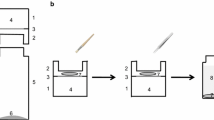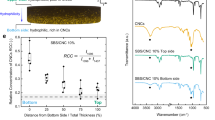Summary
The water permeability of astomatous cuticular membranes isolated from Citrus aurantium L. leaves, pear (Pyrus communis L.) leaves and onion (Allium cepa L.) bulb scales was determined before and after extraction of cuticular waxes with lipid solvents. In pear, the permeability coefficients for diffusion of tritiated water across cuticular membranes (CM) prior to extraction [P d(CM)] decreased by a factor of four during leaf expansion. In all three species investigated P d(CM) values of cuticular membranes from fully expanded leaves varied between 1 to 2×10-7 cm-3 s-1·P d(CM) values were not affected by pH. Extraction of cuticular waxes from the membranes increased their water permeability by a factor of 300 to 500. Permeability coefficients for diffusion of THO across the cutin matrix (MX) after extraction [P d(MX)] increased with increasing pH. P dvalues were not inversely proportional to the thickness of cuticular membranes. By treating the cutin matrix and cuticular waxes as two resistances acting in series it was shown that the water permeability of cuticles is completely determined by the waxes. The lack of the P d(CM) values to respond to pH appeared to be due to structural effects of waxes in the cutin matrix. Cuticular membranes from the submerse leaves of the aquatic plant Potamogeton lucens L. were three orders of magnitude more permeable to water than the cuticular membranes of the terrestrial species investigated.
Similar content being viewed by others
Abbreviations
- CM:
-
cuticular membrane
- MX:
-
cutin matrix
- WAX:
-
waxes
References
Baker, E.A., Bukovac, M.J.: Characterization of the components of plant cuticles in relation to the penetration of 2,4-D. Ann. appl. Biol. 67, 243–253 (1971)
baker, E.A., Procopiou, J.: The cuticles of Citrus species. II. Composition of intracuticular lipids of leaves and fruits. J. Sci. Food Chem. 26, 1347–1352 (1975)
Baker, E.A., Procopiou, J., Hunt, G.M.: The cuticles of Citrus species. Composition of leaf and fruit waxes. J. Sci. Food Chem. 26, 1093–1101 (1975)
Ginzburg, B.Z., Katchalsky, A.: The frictional coefficients of the flows of non-electrolytes through artificial membranes. J. gen. Physiol. 47, 403–418 (1963)
Grncarevic, M., Radler, F.: The effect of wax components on cuticular transpiration-model experiments. Planta (Berl.) 75, 23–27 (1967)
Härtel, O.: Über die pflanzliche Kutikulartranspiration und ihre Beziehung zur Membranquellbarkeit. S.-B. Akad Wiss. Wien, math.-nat. Kl. Abt. I 156, 57–85 (1947)
Huelin, F.E.: Studies on the natural coating of apples. IV. The nature of cutin. Austr. J. Biol. Sci. 12, 175–180 (1959)
Kamp, H.: Untersuchungen über Kutikularbau und kutikuläre Transpiration von Blättern. Jb. wiss. Bot. 72, 403–465 (1930)
Kolattukudy, P.E., Walton, T.J.: The biochemistry of plant cuticular lipids. In: Progress in the chemistry of fats and other lipids XIII/3, 121–175, Ed.: Holman, R.T. Oxford, New York: Pergamon Press 1972
Martin, J.T., Juniper, B.E.: The cuticle of plants. London: Edward Arnolds 1970
Norris, R.F., Bukovac, M.J.: Structure of the pear leaf cuticle with special reference to cuticular penetration. Amer. J. Bot. 55, 975–983 (1968)
Orgell, W.H.: The isolation of plant cuticle with pectic enzymes. Plant Physiol. 30, 78–80 (1955)
Paganelli, C.V., Solomon, A.K.: The rate of exchange of tritiated water across the human red cell membrane. J. gen. Physiol. 41, 259–277 (1957)
Roelofsen, P.A.: The microscopic structure of cell walls. Acta Bot. Neerland. 1, 99–114 (1952)
Schönherr, J.: Water permeability of isolated cuticular membranes: The effect of pH and cations on diffusion, hydrodynamic permeability and size of polar pores in the cutin matrix. Planta (Berl.) 128, 113–126 (1976)
Schönherr, J., Bukovac, M.J.: Ion exchange properties of isolated tomato fruit cuticular membrane: Exchange capacity, nature of fixed charges and cation selectivity. Planta (Berl.) 109, 73–93 (1973)
Sitte, P., Rennier, R.: Untersuchungen an cuticularen Zellwandschichten. Planta (Berl.) 60, 19–40 (1963)
Skoss, J.D.: Structure and composition of plant cuticle in relation to environmental factors and permeability. Bot. Gaz. 117, 55–72 (1955)
Stålfelt, G.M.: Die kutikuläre Transpiration. In: Handbuch der Pflanzenphysiologie Bd. III, 342–350 Ed.: Ruhland, W. Berlin, Göttingen, Heidelberg: Springer 1956
Author information
Authors and Affiliations
Additional information
This study was supported by a grant from the Deutsche Forschungsgemeinschaft.
Rights and permissions
About this article
Cite this article
Schönherr, J. Water permeability of isolated cuticular membranes: The effect of cuticular waxes on diffusion of water. Planta 131, 159–164 (1976). https://doi.org/10.1007/BF00389989
Received:
Accepted:
Issue Date:
DOI: https://doi.org/10.1007/BF00389989




